
Daniel Boone was an American pioneer and frontiersman whose exploits made him one of the first folk heroes of the United States. He became famous for his exploration and settlement of Kentucky, which was then beyond the western borders of the Thirteen Colonies. In 1775, Boone blazed the Wilderness Road through the Cumberland Gap and into Kentucky, in the face of resistance from American Indians, for whom the area was a traditional hunting ground. He founded Boonesborough, one of the first English-speaking settlements west of the Appalachian Mountains. By the end of the 18th century, more than 200,000 people had entered Kentucky by following the route marked by Boone.
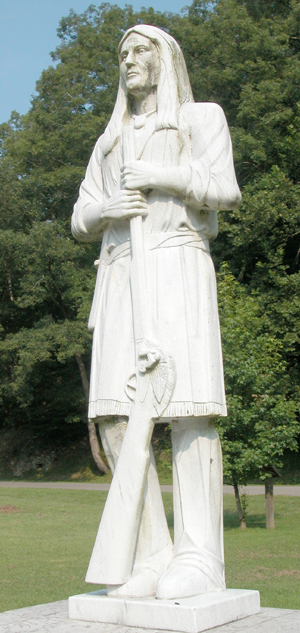
Logan the Orator was a Cayuga orator and war leader born of one of the Six Nations of the Haudenosaunee Confederacy. After his 1760s move to the Ohio Country, he became affiliated with the Mingo, a tribe formed from Seneca, Cayuga, Lenape and other remnant peoples. He took revenge for family members killed by Virginian Long knives in 1774 in what is known as the Yellow Creek Massacre. His actions against settlers on the frontier helped spark Dunmore's War later that year.

Tecumseh was a Shawnee chief and warrior who promoted resistance to the expansion of the United States onto Native American lands. A persuasive orator, Tecumseh traveled widely, forming a Native American confederacy and promoting intertribal unity. Even though his efforts to unite Native Americans ended with his death in the War of 1812, he became an iconic folk hero in American, Indigenous, and Canadian popular history.
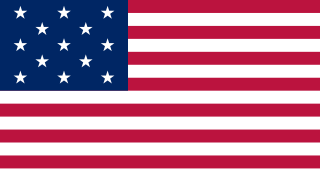
The Northwest Territory, also known as the Old Northwest and formally known as the Territory Northwest of the River Ohio, was formed from unorganized western territory of the United States after the American Revolution. Established in 1787 by the Congress of the Confederation through the Northwest Ordinance, it was the nation's first post-colonial organized incorporated territory.

The Shawnee are a Native American people of the Northeastern Woodlands. Their language, Shawnee, is an Algonquian language.

Return Jonathan Meigs Jr. was a Democratic-Republican politician from Ohio. He served as the fourth governor of Ohio, fifth United States Postmaster General, and as a United States senator.
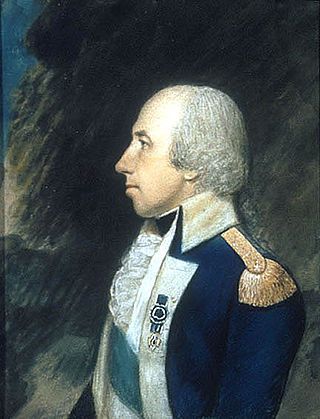
Rufus Putnam was an American military officer who fought during the French and Indian War and the American Revolutionary War. As an organizer of the Ohio Company of Associates, he was instrumental in the initial colonization by the United States of former Native American, English, and French lands in the Northwest Territory in present-day Ohio following the war.
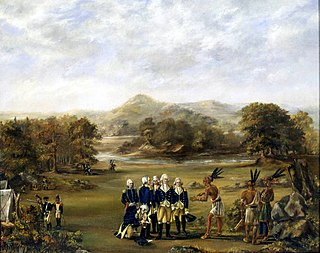
The Northwest Indian War (1785–1795), also known by other names, was an armed conflict for control of the Northwest Territory fought between the United States and a united group of Native American nations known today as the Northwestern Confederacy. The United States Army considers it the first of the American Indian Wars.

Simon Kenton was an American frontiersman and soldier in West Virginia, Kentucky, and Ohio. He was a friend of Daniel Boone, Spencer Records, Thomas S. Hinde, Thomas Hinde, and Isaac Shelby. He served the United States in the Revolution, the Northwest Indian War, and the War of 1812.

Into the West is a 2005 miniseries produced by Steven Spielberg and DreamWorks, with six two-hour episodes. The series was first broadcast in the U.S. on Turner Network Television (TNT) on six Fridays starting on June 10, 2005. It was also shown in the UK on BBC2 and BBC HD from November 4, 2006, and in Canada on CBC Television. The series also aired in the U.S. on AMC during the summer (June/July) and fall of 2012.
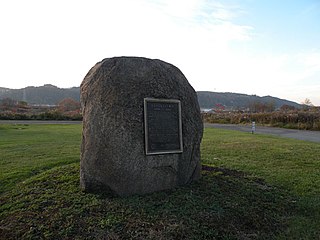
The riverside village of Logstown also known as Logg's Town, French: Chiningue near modern-day Baden, Pennsylvania, was a significant Native American settlement in Western Pennsylvania and the site of the 1752 signing of the Treaty of Logstown between the Ohio Company, the Colony of Virginia, and the Six Nations, which occupied the region. Being an unusually large settlement, and because of its strategic location in the Ohio Country, an area contested by France and England, Logstown was an important community for all parties living along the Ohio and tributary rivers. Logstown was a prominent trade and council site for the contending British and French colonial governments, both of which made abortive plans to construct forts near the town. Logstown was burned in 1754 and although it was rebuilt, in the years following the French and Indian War it became depopulated and was eventually abandoned.

Pierre-Louis de Lorimier, usually anglicized to Peter Loramie, was a colonial French-Canadian fur trader, British Indian agent, and Shawnee agitator. In later years, he founded what became Cape Girardeau and Bollinger Counties, Missouri. He died in Cape Girardeau and was buried there with his Indian wife.

Lower Shawneetown, also known as Shannoah or Sonnontio, was an 18th-century Shawnee village located within the Lower Shawneetown Archeological District, near South Portsmouth in Greenup County, Kentucky and Lewis County, Kentucky. The population eventually occupied areas on both sides of the Ohio River, and along both sides of the Scioto River in what is now Scioto County, Ohio. It was added to the National Register of Historic Places on 28 April 1983. It is near the Bentley site, a Madisonville Horizon settlement inhabited between 1400 CE and 1625 CE. Nearby, to the east, there are also four groups of Hopewell tradition mounds, built between 100 BCE and 500 CE, known as the Portsmouth Earthworks.

Shikellamy, also spelled Shickellamy and also known as Swatana, was an Oneida chief and overseer for the Iroquois confederacy. In his position as chief and overseer, Shikellamy served as a supervisor for the Six Nations, overseeing the Shawnee and Lenape tribes in central Pennsylvania along the Susquehanna River and protecting the southern border of the Iroquois Confederacy. While his birth date is not known, his first recorded historical appearance was in Philadelphia in 1728. In 1728 he was living in a Shawnee village in Pennsylvania near modern Milton, and moved in 1742 to the village of Shamokin, modern day Sunbury, at the confluence of the West and North Branches of the Susquehanna. Shikellamy was an important figure in the early history of the Province of Pennsylvania and served as a go-between for the colonial government in Philadelphia and the Iroquois chiefs in Onondaga. He welcomed Conrad Weiser to Shamokin and served as Weiser's guide on his journeys into the frontier of Pennsylvania and New York.
Alexander McKee was an American-born military officer and colonial official in the British Indian Department during the French and Indian War, the American Revolutionary War, and the Northwest Indian War. He achieved the rank of Deputy Superintendent General in 1794, the second highest position in the British Indian Department at the time.
Wallace Willis was a Choctaw freedman living in the Indian Territory, in what is now Choctaw County, near the city of Hugo, Oklahoma, US. His dates are unclear: perhaps 1820 to 1880. He is credited with composing several Negro spirituals. Willis received his name from his owner, Britt Willis, probably in Mississippi, the ancestral home of the Choctaws. He died, probably in what is now Atoka County, Oklahoma, as his unmarked grave is located there.
Jonathan Alder was an American pioneer, and the first white settler in Madison County, Ohio. As a young child living in Virginia, Alder was kidnapped by Shawnee Indians, and later adopted by a Mingo chief in the Ohio Country. He lived with the Native Americans for many years before returning to the white community.
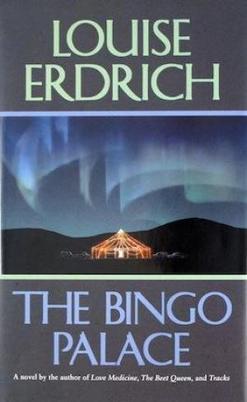
The Bingo Palace is a novel written by Louise Erdrich published in 1994, with three chapters appearing in the Georgia Review, The New Yorker, and Granta. It is the fourth novel in Erdrich's Love Medicine series, and it follows Lipsha Morrissey as he is summoned home by his grandmother Lulu Lamartine. He returns home to the reservation for the first time in years and finds himself in rapture of a woman named Shawnee Ray. The novel discusses themes of family and identity from an Anishinaabe perspective.
Kakowatcheky, also known as Kakowatchiky, Cachawatsiky, Kakowatchy, or Kakowatchey, was a Pekowi Shawnee chief believed to be among the first to bring Shawnee people into Pennsylvania. For about fifty years he and the Shawnees lived together with European colonists in Pennsylvania until the mid-1740s when many Shawnees and other Native Americans migrated to the Ohio River Valley.















